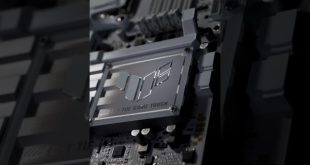Our sample arrived in a green engineering box, as shown above.
The A8-3870K is the replacement for the 3850, and is clocked 100mhz higher @ 3ghz. As we mentioned in the introduction, the ‘K' moniker indicates that this is an unlocked processor, otherwise known in AMD terms as a ‘Black Edition'. The CPU multipliers, GPU and memory multipliers are also unlocked which will prove useful. In the past, the user had to overclock the 3850 via base clock increases, which was less than ideal.
This time around, overclocking is possible by raising the multiplier, making it much easier and less dependent on other components in the system.
We never seem to be able to get validation with these processors, even at reference clock speeds, however the link is here for those interested.
The AMD A8-3870K has four x86 cores which are equipped with 128kb of Level 1 cache, comprising 64kb Data and 64kb Instruction set. It also has 1MB of Level 2 cache per core and no Level 3 cache. This is an APU design so also is equipped with a Direct X 11 capable Radeon HD6550D GPU core. This core runs at a default clock frequency of 600mhz and has 400 Shaders configured in an array of 5 SIMDs. We really aren't focusing on the onboard graphics today as this is basically the same as our previous review detailing the A8-3850.
We were also supplied with an ASUS F1A75-M Pro motherboard for this review today, which is ideal for a small form factor chassis. We didn't receive a retail sample, so we can't comment on the packaging, manual or accessories. It is a Micro ATX board measuring 9.6 inch x 9.6 inch ( 24.4 cm x 24.4 cm ). It is fully loaded with Crossfire, SATA 6 Gb/s and USB 3.0 support.
Asus use a dark PCB with blue ports and accented heatsinks, which is appealing enough to look at. We like the ‘wave' design on the heatsinks, but this will assuredly be personal taste. The board also features ASUS DIGI+ VRM, which has been a long standing implementation on many of their products over the last year. Without quoting too many buzz words, this basically means that the board should be stable under overclocked load, with higher than normal thermal dynamics. We can't imagine a wide audience will be pushing this board to the limit, but it looks as if it should handle some abuse.
The board is equipped with four memory slots which support DDR3 sticks, up to 1866mhz with a total count of 64GB. Next to the DIMM slots is a MemOK! button which assures a successful boot in case of memory related bios problems.
There is also a TPU switch which is an independent microprocessor which will optimise the system for high performance settings, without instability. Voltage and monitoring can then be handled via the supplied TurboV software. Users who don't want to play with a bios, should see a performance increase from simply flicking this switch.
The EPU switch next to it is a power saving option, which can also be enabled via the AI Suite II software. This will help lower power demand depending on the load.
The board has six SATA III ports to accommodate the fastest Solid State Drives. At the far left in the image above is the front header panel for connection to the case. The F1A75-M Pro has two PCI express slots. The top slot is a full x16 bandwidth port for a graphics card and the bottom slot is x4, ideal for an OCZ solid state drive, or sound card. Asus have also included a legacy PCI slot, which may prove useful for some people.
Along the bottom of the board are all the connectors we would expect for AUDIO, USB 2.0 and USB 3.0.
The Back I/O panel supports:
- 1 x PS/2 keyboard/mouse combo port(s)
- 1 x DVI-D
- 1 x D-Sub
- 1 x HDMI
- 1 x LAN (RJ45) port(s)
- 4 x USB 3.0
- 2 x USB 2.0
- 1 x Optical S/PDIF out
- 6 x Audio jack(s)
 KitGuru KitGuru.net – Tech News | Hardware News | Hardware Reviews | IOS | Mobile | Gaming | Graphics Cards
KitGuru KitGuru.net – Tech News | Hardware News | Hardware Reviews | IOS | Mobile | Gaming | Graphics Cards





















Nice cheap system indeed. id like a passive cooler on the CPU, even to underclock and undervolt it. wonder is that possible?
2ghz would probably be more than enough for bluray playback.
I love passive video cards, dont think this one is really for gamers, but more for acceleraing video and stuff and being quiet. I like this system more than some of the high end things you review. , all about the green environm,ent too.
Nice, cheap setup and more than enough for most people. You could also replace that 6450 with something more powerful, although it would be noisier obviously